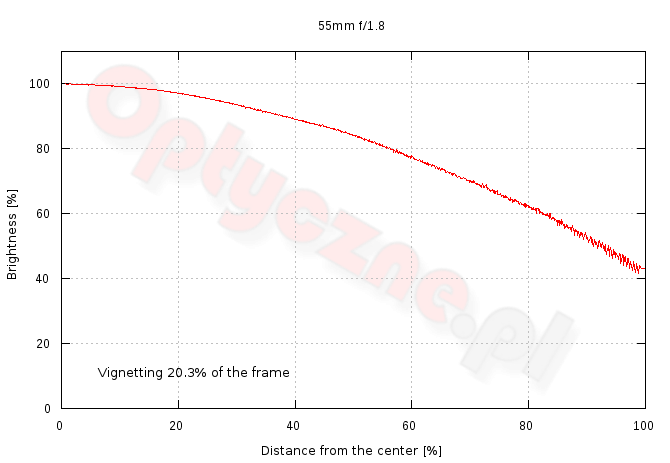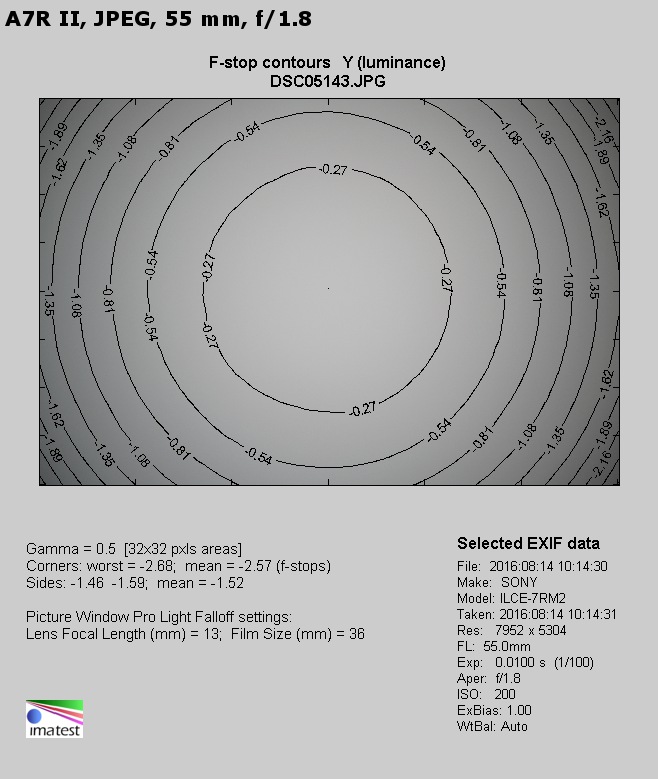Sony Carl Zeiss Sonnar T* FE 55 mm f/1.8 ZA
8. Vignetting
| A7R II, APS-C, f/1.8 | A7R II, APS-C, f/2.0 |

|

|
| A7R II, APS-C, f/2.8 | A7R II, APS-C, f/4.0 |

|

|
At the maximum relative aperture the vignetting is noticeable even on the smaller sensor reaching 27% (−0.90 EV). On slight stopping down to f/2.0 that aberration decreases to 20% (−0.80 EV). By f/2.8 and f/4.0 you might speak about the end of vignetting problems; the result we got were, respectively, 9% (−0.27 EV) and 6% (−0.18 EV).
Please Support UsIf you enjoy our reviews and articles, and you want us to continue our work please, support our website by donating through PayPal. The funds are going to be used for paying our editorial team, renting servers, and equipping our testing studio; only that way we will be able to continue providing you interesting content for free. |
- - - - - - - - - - - - - - - - - - - - - - - - - - - - - - - - - - - - - - - - - - - - - - - -
Now let’s check how the situation changes after progressing to full frame – appropriate thumbnails are presented below.
| A7R II, FF, f/1.8 | A7R II, FF, f/2.0 |

|

|
| A7R II, FF, f/2.8 | A7R II, FF, f/4.0 |

|

|
The brightness loss in the frame corners at the maximum relative aperture amounts to as much as 59% (−2.57 EV). It’s a lot. Just a slightly higher result, that of 61% had the Canon EF 50 mm f/1.8 STM but the Nikkor AF-S 50 mm f/1.8G fared noticeably better (44%), and the Tamron’s SP 45 mm f/1.8 Di VC USD vignetting was just 37%.
The vignetting of the Sonnar 1.8/55 FE decreases quite slowly on stopping down. By f/2.0 it amounts to 53% (−2.18 EV), and by f/2.8 it still remains noticeable, getting to 35% (−1.25 EV). That last result is the worst in the whole group, worse even than the performance of the Canon EF 50 mm f/1.8 STM, a device we criticized harshly in this category.
The value we saw by f/4.0, reaching 30% (−1.0 EV) still might be already noticed in photos. A moderate level can be achieved only by f/5.6 and f/8.0, where we got, respectively, 25% (−0.82 EV) and 18% (−0.59 EV). The vignetting disappears almost completely only by f/11 where it is just 13% (−0.42 EV).
Below we present the averaged out values of brightness loss in concentric circles as you move away from the frame centre. The percentage numbers in every picture state the size of the real surface area limited from above and from the right with a value of 100% and from below by the presented curve. That’s how you know how much light overall is lost due to the vignetting. Still you shouldn’t mix up those percentage values with the ones, given at the beginning of the chapter because they are not directly connected with each other.

 |






